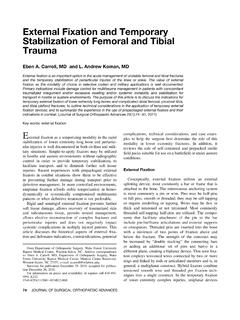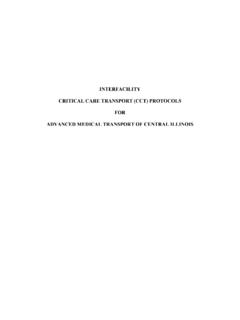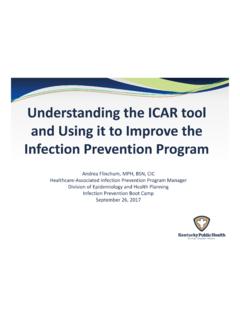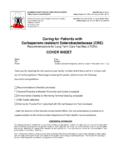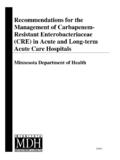Transcription of Advanced Rehabilitation Techniques for the Multi-Limb …
1 Advanced Rehabilitation Techniques forthe Multi-Limb AmputeeZach T. Harvey, CPO; Gregory A. Loomis, MPT; Sarah Mitsch, MS, OTR/L;Ian C. Murphy, BA; Sarah C. Griffin, BASc; MAJ Benjamin K. Potter, MD; COL PaulPasquina, MDAdvances in combat casualty care have contributed to unprecedented survival rates of battlefield injuries,challenging the field of Rehabilitation to help injured service members achieve maximal functional recoveryand independence. Nowhere is this better illustrated than in the care of the multiple- limb medical, surgical, and rehabilitative interventions are needed to optimize the care of thisunique patient population. This article describes lessons learned at Walter Reed National Military MedicalCenter Bethesda in providing Advanced therapy and prosthetics for combat casualties, but providesguidelines for all providers involved in the care of individuals with amputation.
2 ( Journal of SurgicalOrthopaedic Advances 21(1):50 57, 2012)Key words: Rehabilitation , amputee, amputation, therapy, war injuryIntroductionAdvances in battlefield medicine, improved bodyarmor, more rapid medical evacuation, and modern resus-citation Techniques have led to an unprecedented survivalrate among military service members who sustain combat-related injuries. Today, combat casualties from Iraq andAfghanistan are surviving devastating injuries that wouldhave been fatal in previous wars. As a result, the militaryThe views expressed in this article are those of the authors and donot necessarily reflect the official policy or position of the Departmentof the Navy, Department of the Army, Department of Defense, nor theU. S. work was prepared as part of the authors official duties asservice members.
3 Title 17 105 provides that Copyright protec-tion under this title is not available for any work of the United StatesGovernment. Title 17 101 defines a United States Governmentwork as a work prepared by a military service member or employee ofthe United States Government as part of that person s official authors certify that all individuals who qualify as authors havebeen listed; each has participated in the conception and design ofthis work, the analysis of data, the writing of the document, and theapproval of the submission of this version; that the document representsvalid work; that if we used information derived from another source,we obtained all necessary approvals to use it and made appropriateacknowledgements in the document; and that each takes public responsi-bility for it.
4 Nothing in the presentation implies any Federal/ the Walter Reed National Military Medical Center and theCenter for Rehabilitation Sciences Research, Uniformed Services Univer-sity of the Health Sciences, Bethesda, MD. Please send correspondenceto: COL Paul F. Pasquina, MD, Walter Reed National Military MedicalCenter, 8901 Wisconsin Avenue, Department of Orthopaedics & Reha-bilitation, Bldg 19, Bethesda, MD : for publication November 25, 2011; accepted for publica-tion December 12, information on pricings and availability of reprints, or call 410-494-4994, $ system has needed to respond by advancing thefield of Rehabilitation to help our nation s heroes reachtheir maximum functional recovery and is this more apparent than in the care of thecombat multiple- limb of December 2011, nearly 1,400 service membershave had a major limb amputation as the result of combatwounds sustained in Iraq and Afghanistan, with over 20%of these members losing more than one limb .
5 A recentreport from the Army Surgeon General s DismountedComplex Blast Injury Task Force noted that the inci-dence of double, triple,and even quadruple amputationshas significantly increased over the past 2 years (1).Further distinguishing this group of amputees from theircivilian counterparts is their relatively young age and highincidence of multiple other co-morbid injuries, such asfractures, soft tissue damage, peripheral nerve injury, trau-matic brain injury, and psychological health problems. Tobest meet these unique needs, it became necessary for themilitary to develop Centers of Excellence for AmputeeCare, which emphasize coordinated interdisciplinary care,holistic patient management, and the use of innovativetechnologies applied in a sports medicine state-of-the-art programs currently exist at WalterReed National Military Medical Center Bethesda(WRNMMCB) in Bethesda, MD.
6 The Center for theIntrepid (CFI) in San Antonio, TX, and the Naval MedicalCenter in San Diego, and Surgical ManagementThe medical and surgical principles needed to optimizethe rehabilitative care for multiple- limb combat amputees50 JOURNAL OF SURGICAL ORTHOPAEDIC ADVANCESC opyright 2012 by the Southern Orthopaedic Associationare very similar to those used for all trauma priority is to intervene to preserve life, limb , andvision beginning from the time of injury and continuingthroughout the medical evacuation process. When amputa-tion is necessary, wound closure is typically delayed untilconditions are optimized for wound healing. This entailsdebriding all non-viable or infectious tissue, selecting theoptimal length of the amputation, and achieving adequatesoft tissue coverage of the residual limb .
7 Every effortis made to preserve limb joints, such as the shoulder,elbow, hip and knee, in order to promote improved long-term functional outcomes. This often requires performingcreative skin grafts or muscle flaps that may prolong thetime of healing and delay prosthetic fitting and , it is important to start Rehabilitation assoon as possible during the hospital course. Early rangeof motion exercises should be implemented immediatelyto prevent joint and soft tissue contractures. Regularskin surveillance, appropriate turning, and pressure reliefshould be initiated to reduce breakdown and ulceration. Inaddition, it is essential to challenge the cardiovascular andmusculoskeletal system to help minimize the effects ofimmobility, such as deconditioning and bone adequate pain control is particularly chal-lenging in caring for the combat casualty with multiplelimb loss.
8 It is often necessary to use a combinationof approaches, including continuous regional anesthesia,epidural blocks, patient-controlled analgesia (PCA), oralmedications ( , opioids, anticonvulsants, antidepres-sants, and NMDA receptor antagonists), as well as localmodalities, such as heat, ice, massage, and electrical stim-ulation. A multi -modal approach to pain management canhelp decrease the required dosage of a single medication,thereby minimizing the risk of side effects associated withdose escalation. This is particularly important when usingopioid medications, as this practice may reduce the risk ofdeveloping tolerance, dependence, or addiction. Becausepain may adversely affect an individual s ability to partic-ipate in therapy, premedication with a short-acting opioidprior to therapy sessions may be very helpful.
9 Conversely,over-medication prior to therapy may lead to excessivedrowsiness and the inability to attend to tasks. In order tooptimize pharmacologic management, frequent communi-cation must occur between the patient, nursing staff, andtrauma and Rehabilitation teams through regularly sched-uled interdisciplinary particular concern when caring for the combatamputee is the presence of co-existing traumatic braininjury (TBI) and/or psychological health problems. Inorder for Rehabilitation to be successful, the patient mustbe able to demonstrate the ability to follow commands,attend to tasks, and show steady learning the presence of TBI significantly interferes with theserequirements, it is best to transfer the patient to a special-ized in-patient TBI Rehabilitation facility, such as one ofthe Polytrauma Centers that exist in the Department ofVeterans Affairs (VA) system.
10 Upon sufficient recoveryfrom their brain injury, the patient may then return to themilitary system for Advanced amputee care if health problems may also negativelyimpact Rehabilitation . Because of the high incidenceof conditions such as anxiety, depression, and post-traumatic stress disorder (PTSD) , access to experiencedbehavioral health experts is a vital aspect of rehabili-tative care. At WRNMMCB, all combat casualties areseen by the Preventative Psychiatric Consultative LiaisonService. This not only ensures early evaluation andintervention, but also helps to destigmatize any nega-tive perception about seeking psychiatric help. It is notuncommon, however, for the patient or patient s familyto form a closer relationship with one of the memberson the Rehabilitation team other than with the behav-ioral health expert.
